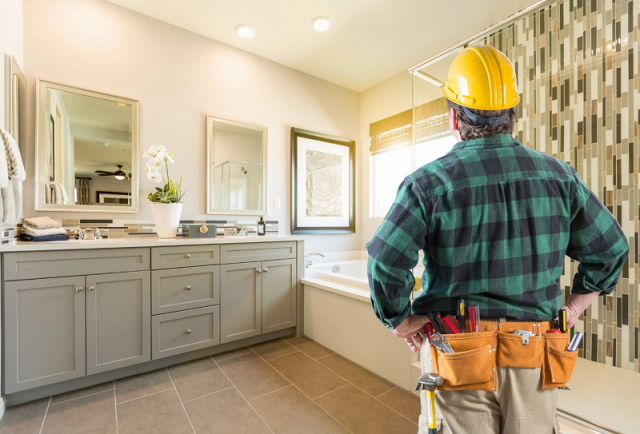Everyone loves a good kitchen or bathroom remodel. They're some of the most popular home improvement projects these days because they add so much resale value. But, those benefits bloom out of the relationship between the interior remodeling contractors and local electrical supply partners you choose.
Electrical work is an often overlooked part of the renovation timeline. It has a role at almost every stage. For example, you need to rough-in wiring before closing the walls, and usually, install new fixtures. Without planning for those things, you'll run into issues like delays or conflict with plumbing /cabinetry. These issues could even lead to expensive rework, which is why electrical needs to be considered from the start.
Your home's wiring system needs to handle the new appliances, lighting, or layout configurations you're installing. That's why interior remodeling contractors and local electrical supply providers make such great partners. When they're working together, you get a beautiful, functional, and most importantly, safe, remodel.
Why Should Electrical Planning is Crucial for Kitchen and Bathroom Remodels?
What happens if you skip electrical planning during a remodel? Ignoring electrical work during remodeling can result in code violations, overloaded circuits, and costly rework. Updating your wiring during a remodel is a safer, more efficient way to future-proof your home.
Without the right planning for electrical work, you might have to open up new walls to fix mistakes. You also might not have enough outlets for for all your appliances or have to rely on electrical cords.
Your devices will have to compete for the same plugs, which can cause frequent tripped breakers and possible overheating. Meanwhile, over relying on electrical cords creates serious shock and fire hazards. Whatever you do, don't get them wet.
Worse, outdated or undersized wiring might not be able to handle your new appliances. The lights could flicker and panels can overload. Electrical failures like that can damage your equipment and create even more safety risks.
That's why it's important to source reliable components from a trusted local electrical supply store. You can trust them to offer the highest quality materials that minimize long-term risks.
Common Electrical Issues in Kitchen & Bathroom Renovations: What to Watch For
What should homeowners watch out for during electrical upgrades? During remodeling, common electrical issues include outdated wiring, poor load planning, missing GFCIs, and insufficient outlet spacing. These issues are easier and cheaper to fix during a renovation than after.
Kitchen and bathroom remodels come with their own set of electrical challenges. These rooms often need more power, more outlets, and stricter safety precautions than the rest of the home. If you don't expect these needs, your finished space could fall short of modern standards.
- Outdated wiring: Many older homes still rely on aluminum or knob-and-tube wiring, which isn't suitable for modern electrical loads. Remodeling is the perfect time to upgrade to safer, more efficient wiring.
- GFCI requirements: Kitchens and bathrooms are “wet zones,” so they need GFCI (Ground Fault Circuit Interrupter) outlets to prevent electric shocks.
- Too few circuits: Adding appliances or fixtures without rethinking your electrical load can overwhelm your current service panel. If that's the case, breakers can trip and power can flicker.
- Inadequate lighting plans: Without a plan, you might end up with shadowy corners or insufficient light for tasks like cooking or grooming.
Tackling these common issues early keeps your remodel on schedule and ensures a safe, functional result. The next step is finding the right partners to help. Let's start with a reliable local electrical supply store that can match your needs.
Benefits of Partnering with a Local Electrical Supply Store for Remodels
Why work with a local supplier instead of a big-box store? A local electrical supply store offers expert advice, high-quality materials, and personalized service tailored to your project. They often carry better-grade materials than general hardware chains.
Remodeling kitchens and bathrooms requires precise, code-compliant electrical components. Appliances in them like dishwashers and ventilation systems need more power than other rooms.
They also have more complex lighting needs. Common activities like cooking and grooming require task, ambient, and accent lighting. That requires a lot of fixtures, each of which must be rated for damp/wet locations.
Local electrical suppliers are attuned to these demands. They partner with interior remodeling contractors to provide safe, reliable materials. Of course, these materials are also tailored to the design and layout of each project.
They can also be more flexible and responsive than national chains. If your contractor needs to swap out a fixture or adjust quantities, you won't be waiting days for a restock or dealing with generic customer service. Many local vendors will even communicate directly with your contractor or electrician to troubleshoot challenges or recommend alternatives.
Coordinating Electrical Upgrades with Your Interior Remodeling Contractor
How can remodeling contractors help coordinate electrical upgrades? Experienced interior remodeling contractors work with electricians to plan safe and code-compliant electrical layouts that support your renovation goals. They identify where electrical needs intersect with cabinetry, plumbing, and finishes.
Contractors look at your floorplan, appliance layout, and how you intend to use the space day-to-day. They make sure outlets are placed where they'll be used, not hidden behind cabinets or out of reach. They also check natural light levels, making sure you have enough task and ambient lighting.
Your contractor builds the renovation timeline around key milestones like demolition, rough electrical, and inspections. They'll work with an electrician to make sure wiring is done before the walls are closed. Your final fixtures and faceplates will also be mounted after the painting or tile work is done. This helps avoid costly delays or do-overs.
If your contractor has worked with your local electrical supplier before, this can also speed up material ordering and troubleshooting. They're already familiar with product availability and local code requirements.
Essential Electrical Products from a Local Supplier for Remodeling
What components are worth sourcing from a trusted local vendor? Quality materials reduce risk of failure and help your upgrades last. A local electrical supply store can recommend code-compliant and durable products suited for bathrooms and kitchens.
When planning a remodel, it's not just about design. You also need to think about what's behind the walls. The products you use for your electrical system have a direct impact on performance, safety, and longevity. Local suppliers help match the right materials to your specific layout and electrical load.
Here's what you should consider sourcing locally:
- Wiring and breakers: Every remodel is built on these. Using high-quality wire and dependable breakers protects your home's safety. It minimizes the risk of shorts, overheating, or fire caused by overloaded or poorly insulated lines. They also support consistent performance under modern electrical loads.
- Switches, dimmers, and outlets: Bathrooms and kitchens need moisture-resistant models. Inferior switches or outlets can corrode or fail prematurely in damp conditions. Tamper resistant designs also reduce the risk of electrical shock.
- Lighting fixtures: Local suppliers can help you find practical and beautiful task lighting, ambient lighting, and accent lighting. Many fixtures also need to meet damp or wet location ratings. Local vendors can ensure you're getting options that are both stylish and code-compliant.
- GFCI and AFCI devices: GFCI (for water protection) and AFCI (for fire prevention) are required in specific areas. Make sure you're buying the right type. Properly rated protection devices help shut off power when danger is detected. That prevents shocks or electrical fires in kitchens and bathrooms.
- Electrical boxes and conduit: These must be the right size and material to meet safety codes and prevent overheating. Cheap or undersized boxes can lead to crowded wiring. That increases the risk of arcing, insulation damage, or code violations during inspection.
Choosing the right products from a local source helps your home's electrical system hold up over time. It also positions your remodel for future-ready upgrades.
Future-Proofing Electrical Systems in Kitchen & Bathroom Remodels
What are smart upgrades to include now? While remodeling, include upgrades that support future tech and increased load. It's easier and more affordable to install these systems now than later.
Kitchen and bathroom remodels solve current problems, sure, but they're also a great way to install proactive upgrades for the future. Work is already being done, so future proofing your wiring and appliance configuration avoids having to do it later. Your contractor and local electrical supplier can help you make decisions now that prevent limitations later.
Smart upgrades to consider:
- Dedicated appliance circuits: Prevent breaker trips by assigning major appliances their own circuits. This reduces the chance of overloads and helps avoid flickering lights or power interruptions.
- USB outlets: Convenient charging without adapters. They help reduce clutter and free up standard outlets for appliances or grooming tools. Local suppliers can help you choose safe, durable models that won't wear out after limited use.
- Smart lighting or switches: Add app or voice control to lights, fans, and more. Smart controls improve convenience, energy efficiency, and long-term adaptability. Your contractor can ensure the wiring supports these systems cleanly and safely.
- Undercabinet and toe-kick lighting: Enhance visibility and style in kitchens and bathrooms. These features add functionality to prep spaces and improve nighttime navigation. Your supplier can recommend moisture-rated fixtures that last.
- Upgraded service panel: Accommodates modern appliances, home offices, and future needs like EV chargers. A larger panel allows for more circuits and avoids costly upgrades later. Your local electrical supplier can help match the panel to your expected load growth.
By coordinating these upgrades with your remodeling contractor and sourcing dependable products from a local electrical supply store, you'll avoid having to retrofit your home again, at least for a while. Planning for the future now means your remodel will keep up with your life.
FAQ: Electrical and Remodeling Questions Homeowners Ask
Do I need a permit for electrical work during remodeling?
Yes. Electrical work usually requires a permit to meet local codes and pass inspection.
Can I do my own electrical work?
DIY electrical work is risky and often illegal without proper licensing. Always consult a licensed electrician.
What is the difference between GFCI and AFCI?
GFCI protects against water-related electrical shocks. AFCI guards against arc faults that can cause fires. Kitchens and bathrooms may need both.
Work With the Right Partners for Lasting Results
A successful remodel is about safety, usability, and long-term satisfaction. Ignoring the electrical side of things may save money upfront, but it usually leads to frustration or risk later on.
Working with experienced interior remodeling contractors ensures that your kitchen or bathroom upgrade is carefully planned from start to finish. Pair that with quality materials from a knowledgeable local electrical supply partner, and you'll get a result that looks good, functions well, and lasts for years.
Before you demo your old kitchen or tear out a bathroom vanity, take time to map out your electrical needs. It's a decision you won't regret.






